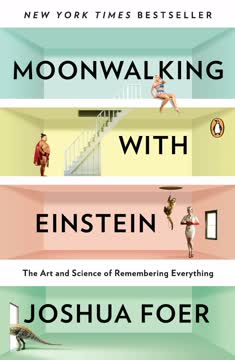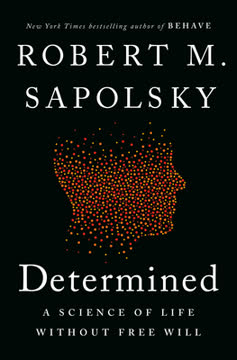Key Takeaways
1. Love is essential for human survival and thriving
We spend our days chasing after the most fleeting things, those desires that never last.
Biological necessity. Love is not just a luxury or a pleasant emotion, but a fundamental biological need crucial for human survival and development. Throughout human evolution, the capacity for strong emotional bonds has been essential for the care and nurturing of children, who require an extended period of dependency. This need for attachment extends beyond childhood, influencing our physical and mental health throughout our lives.
Scientific evidence. Research across various disciplines, from neuroscience to psychology, consistently demonstrates the profound impact of love on human well-being:
- Improved immune function
- Lower stress levels
- Increased longevity
- Better mental health outcomes
- Enhanced cognitive function
The absence of love and strong attachments can lead to significant negative outcomes, including increased risk of disease, mental health disorders, and even premature death.
2. Attachment theory explains how early relationships shape our lives
If we are going to live happily ever after, Aristophanes suggests, we need to find that one person who is perfect for us.
Foundational concept. Attachment theory, developed by John Bowlby and Mary Ainsworth, posits that the quality of our early relationships, particularly with primary caregivers, shapes our expectations and behaviors in future relationships. This theory has revolutionized our understanding of human development and interpersonal dynamics.
Key attachment styles:
- Secure: Comfortable with intimacy and independence
- Anxious: Preoccupied with relationships, fear of abandonment
- Avoidant: Uncomfortable with closeness, values self-reliance
- Disorganized: Conflicting behaviors, often due to trauma
These attachment styles, formed in early childhood, influence our:
- Emotional regulation
- Self-esteem
- Ability to form and maintain relationships
- Response to stress and adversity
Research has shown that attachment patterns tend to persist into adulthood, affecting romantic relationships, friendships, and even professional interactions. However, it's important to note that attachment styles can change through significant life experiences, therapy, or conscious effort.
3. Secure attachment leads to better life outcomes
If monkeys have taught us anything, it's that you've got to learn how to love before you learn how to live.
Lifelong benefits. Secure attachment, characterized by consistent and responsive caregiving in early life, sets the stage for numerous positive outcomes throughout an individual's lifespan. This foundational sense of security and trust in relationships creates a robust platform for personal growth and resilience.
Research has consistently shown that securely attached individuals tend to experience:
- Higher self-esteem and self-confidence
- Better emotional regulation and stress management
- More satisfying and stable romantic relationships
- Improved academic and career performance
- Lower rates of mental health issues like anxiety and depression
- Stronger social skills and larger support networks
Intergenerational impact. The effects of secure attachment extend beyond the individual, creating a positive cycle that can benefit future generations. Parents who experienced secure attachment are more likely to provide the same for their children, fostering emotional well-being across generations.
4. Love requires effort and commitment to endure
We don't love our kids despite their demands; we love them because of them. Caregiving makes us care.
Active process. Contrary to popular notions of effortless romance, enduring love requires consistent effort and commitment. The initial passion and excitement of a new relationship naturally fade over time due to habituation, but this doesn't mean love has diminished. Instead, it evolves into a deeper, more complex form of attachment.
Key elements for maintaining lasting love:
- Open communication
- Emotional vulnerability
- Shared experiences and goals
- Willingness to compromise
- Regular expressions of affection and appreciation
- Addressing conflicts constructively
- Supporting each other's personal growth
Overcoming challenges. Every relationship faces obstacles, from external stressors to internal conflicts. The ability to navigate these challenges together strengthens the bond between partners. This process of working through difficulties can lead to increased intimacy and a more resilient relationship over time.
5. Memory plays a crucial role in sustaining love
We are the stars of the tales we tell, but we are also the authors, searching for a way through. We write the words that define our lives.
Shared narratives. Our memories of shared experiences, both positive and negative, form the foundation of our relationships. These collective memories create a unique bond between individuals, shaping their shared identity and reinforcing their connection over time.
The role of memory in love:
- Strengthens emotional bonds through shared history
- Provides context for understanding each other
- Offers comfort and security in times of stress
- Creates a sense of continuity and shared identity
- Helps navigate conflicts by recalling past resolutions
Reconstructive nature. It's important to recognize that memory is not a perfect record but a reconstructive process. Each time we recall an event, we subtly alter it. This malleability of memory can be both a challenge and an opportunity in relationships, allowing couples to reframe past experiences in ways that strengthen their bond.
6. Meaning and purpose are vital for resilience in life and love
What we want most of all is not some superficial happiness, but a feeling that lasts. Someone to be happy about. We want this because we need it.
Existential foundation. Viktor Frankl's experiences in Nazi concentration camps led him to conclude that having a sense of meaning and purpose is crucial for human resilience and well-being. This principle applies equally to love and relationships, providing a deeper motivation for maintaining connections even in challenging times.
Key aspects of meaning in love:
- Shared goals and values
- Feeling of belonging and connection
- Sense of personal growth and development
- Contributing to something larger than oneself
- Finding purpose through mutual support and care
Transcending difficulties. When couples have a strong sense of shared meaning and purpose, they are better equipped to navigate hardships and conflicts. This shared vision provides a context for individual sacrifices and compromises, making them feel worthwhile in service of a greater goal.
7. Grit and perseverance are key to lasting relationships
Love is a labor. Even good sex takes work. When a relationship endures, it is not because the flame never burns out. It is because the flame is always being relit.
Beyond passion. While initial attraction and compatibility are important, the longevity of a relationship often depends more on the partners' ability to persist through challenges. This quality, often referred to as "grit," involves maintaining commitment and effort over extended periods, even when faced with obstacles or setbacks.
Components of grit in relationships:
- Emotional resilience
- Willingness to adapt and compromise
- Patience and understanding
- Ability to forgive and move forward
- Commitment to personal and relational growth
Long-term perspective. Gritty individuals in relationships understand that momentary difficulties do not define the overall quality or potential of the partnership. They maintain a long-term perspective, working through challenges with the belief that their efforts will yield a stronger, more fulfilling relationship over time.
8. Love has the power to heal and transform
The vision of love that emerges from these studies is a long way from Romeo and Juliet. Those teenagers pretended that love is a pleasure so intense it eclipses every pain. They assumed that relationships provide their own forward momentum, and that finding an enduring love was simply a matter of falling for the right person. But that is a fantasy, a most dangerous myth. Love is not something we solve at first sight—it is what solves us over time, revealing whom we can become, and what we cannot live without.
Transformative potential. Love, in its various forms, has a profound capacity to heal emotional wounds, foster personal growth, and bring about positive change in individuals and communities. This healing power extends beyond romantic relationships to encompass familial love, friendships, and even broader forms of compassion and altruism.
Ways love can heal and transform:
- Providing emotional support and security
- Encouraging personal growth and self-improvement
- Offering new perspectives and experiences
- Fostering resilience in the face of adversity
- Creating a sense of belonging and connection
Neuroplasticity and love. Scientific research has shown that loving relationships can actually change the structure and function of the brain, promoting neuroplasticity and enhancing cognitive and emotional capabilities. This demonstrates that love is not just an emotional experience but a powerful force for physiological and psychological transformation.
Last updated:
FAQ
1. What is A Book About Love by Jonah Lehrer about?
- Exploration of love’s endurance: The book investigates how love persists over time, contrasting fleeting passion with lasting attachment, and argues that love is “what never gets old.”
- Scientific and personal approach: Lehrer blends scientific research, especially from psychology and neuroscience, with personal stories to unravel love’s complexity.
- Attachment and meaning: Central themes include attachment theory, the endurance of love, and how love shapes human experience through meaning, grit, and resilience.
2. Why should I read A Book About Love by Jonah Lehrer?
- Nuanced understanding of love: The book challenges simplistic notions of love as mere passion or chemistry, offering a deeper, science-backed perspective.
- Bridges science and emotion: Lehrer’s blend of rigorous research and heartfelt storytelling appeals to both academic and general readers.
- Practical relationship insights: Readers gain tools to appreciate, nurture, and sustain their own relationships, learning that love is a continual process requiring effort.
3. What are the key takeaways from A Book About Love by Jonah Lehrer?
- Love’s endurance is central: The true miracle of love is its ability to persist and deepen over time, not just its initial spark.
- Attachment shapes relationships: Early bonds with caregivers influence adult romantic relationships, trust, and conflict resolution.
- Love requires work: Enduring love is built on effort, communication, and resilience, not just passion or fate.
- Meaning and narrative matter: The stories we tell about our relationships and the meaning we find in love are crucial for long-term satisfaction.
4. What are the best quotes from A Book About Love by Jonah Lehrer and what do they mean?
- “Love is just another name for what never gets old.” This highlights the book’s central idea that true love endures beyond novelty and passion.
- “Love is the opposite of underwear.” Lehrer uses this metaphor to contrast love’s persistence with the psychological law of habituation.
- “These violent delights have violent ends.” Quoting Shakespeare, Lehrer warns about the fleeting nature of limerence and the dangers of confusing it with lasting love.
- “The meaning of life is to help others find meaning in theirs.” Drawing from Viktor Frankl, the book emphasizes love’s role in giving life purpose, especially in hardship.
5. How does A Book About Love by Jonah Lehrer explain attachment theory and its impact on relationships?
- Origins and experiments: Attachment theory, developed by John Bowlby and Mary Ainsworth, shows how early bonds with caregivers shape emotional development.
- Attachment styles: The book details secure, avoidant, and anxious (resistant) attachment styles, linking them to parenting sensitivity and later relationship patterns.
- Long-term effects: Early attachment quality predicts social competence, mental health, and romantic relationship success decades later.
6. What is habituation, and how does Jonah Lehrer relate it to love in A Book About Love?
- Definition of habituation: Habituation is the psychological process where repeated exposure to a stimulus leads to decreased sensitivity and interest.
- Contrast with love: Lehrer argues that while most pleasures fade with repetition, love is unique in its ability to endure and even deepen over time.
- Metaphors and examples: He uses examples like underwear and chocolate cake to illustrate habituation, positioning love as its “antithesis.”
7. How does A Book About Love by Jonah Lehrer define and discuss limerence?
- Definition of limerence: Limerence is described as an intense, obsessive infatuation, marked by emotional highs and lows and intrusive thoughts.
- Temporary and unstable: Research shows limerence rarely lasts beyond a few years and is often based on little real experience.
- Contrast with real love: Lehrer warns that limerence is a chemical fiction and a risky foundation for lasting relationships, unlike enduring attachment.
8. What does A Book About Love by Jonah Lehrer say about the evolutionary and biological basis of love?
- Attachment in animals: Many animals, such as chimpanzees and goslings, display attachment behaviors, suggesting love’s deep evolutionary roots.
- Human uniqueness: Humans’ extended dependency period after birth necessitates durable emotional bonds to ensure survival and caregiving.
- Love as sacrifice: The book uses stories like Abraham’s to illustrate that love involves sacrifice and grows through effort and struggle.
9. How does Jonah Lehrer describe the role of attunement in parenting and love in A Book About Love?
- Definition of attunement: Attunement is the process by which caregivers and children synchronize emotions and behaviors, creating a shared emotional state.
- Scientific evidence: Experiments like the “still face” show the distress caused by lack of attunement, while secure attachments help children regulate stress.
- Parental learning: Attunement is a skill developed through practice and presence, essential for building secure attachment and healthy relationships.
10. What insights does A Book About Love by Jonah Lehrer offer about adult romantic relationships and marriage?
- Attachment styles in adults: Adult romantic relationships mirror infant attachment patterns, influencing intimacy, trust, and conflict resolution.
- Companionate love vs. passion: While passion fades due to habituation, companionate love—deep affection and commitment—grows over time.
- Work of love: Lasting relationships require ongoing effort, communication, empathy, and compromise, with therapies like EFT helping couples strengthen bonds.
11. How does A Book About Love by Jonah Lehrer address divorce, its impact, and the role of resilience?
- Varied outcomes for children: About 75% of children cope successfully with divorce, but a significant minority face lasting emotional and behavioral challenges.
- Long-term effects: Children of divorce are at higher risk for issues like lower academic achievement and health problems, but many adults find happiness in remarriage.
- Resilience and social support: The book emphasizes the importance of social networks, personal resilience, and narrative coherence in overcoming the challenges of divorce.
12. What does A Book About Love by Jonah Lehrer reveal about the role of meaning, memory, and grit in sustaining love?
- Memory reconsolidation: Memories of love are dynamic and change each time they are recalled, allowing relationships to be continually reinterpreted and sustained.
- Grit and endurance: Lasting love requires grit—passion and perseverance for long-term goals—helping couples persist through challenges.
- Meaning and narrative: The way couples tell the story of their relationship and find meaning in love predicts future satisfaction and resilience, echoing Viktor Frankl’s insights on love as a source of purpose.
Review Summary
A Book About Love explores attachment, relationships, and different forms of love through scientific research and personal anecdotes. Readers appreciate Lehrer's honesty about past mistakes and his engaging writing style. The book offers insights on parent-child bonds, marriage, faith, and memory's role in sustaining love. While some find it dry or unoriginal, others praise its depth and accessibility. Many readers found the content thought-provoking and applicable to their own lives, though opinions vary on Lehrer's approach and conclusions.
Similar Books









Download PDF
Download EPUB
.epub digital book format is ideal for reading ebooks on phones, tablets, and e-readers.







